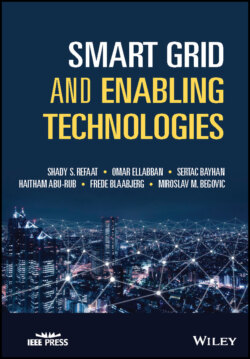Читать книгу Smart Grid and Enabling Technologies - Frede Blaabjerg - Страница 2
Table of Contents
Оглавление1 Cover
6 Preface
9 1 Smart Grid Architecture Overview 1.1 Introduction 1.2 Fundamentals of a Current Electric Power System 1.3 Limitations of the Traditional Power Grid 1.4 Smart Grid Definition 1.5 Smart Grid Elements 1.6 Smart Grid Control 1.7 Smart Grid Characteristics 1.8 Transformation from Traditional Grid to Smart Grid 1.9 Smart Grid Enabling Technologies 1.10 Actions for Shifting toward Smart Grid Paradigm 1.11 Highlights on Smart Grid Benefits 1.12 Smart Grid Challenges 1.13 Smart Grid Cost 1.14 Organization of the Book References
10 2 Renewable Energy 2.1 Introduction 2.2 Description of Renewable Energy Sources 2.3 Renewable Energy: Growth, Investment, Benefits and Deployment 2.4 Smart Grid Enable Renewables 2.5 Conclusion References
11 3 Power Electronics Converters for Distributed Generation 3.1 An Overview of Distributed Generation Systems with Power Electronics 3.2 Power Electronics for Grid‐Connected AC Smart Grid 3.3 Power Electronics Enabled Autonomous AC Power Systems 3.4 Power Electronics Enabled Autonomous DC Power Systems 3.5 Conclusion References
12 4 Energy Storage Systems as an Enabling Technology for the Smart Grid 4.1 Introduction 4.2 Structure of Energy Storage System 4.3 Energy Storage Systems Classification and Description 4.4 Current State of Energy Storage Technologies 4.5 Techno‐Economic Characteristics of Energy Storage Systems 4.6 Selection of Energy Storage Technology for Certain Application 4.7 Energy Storage Applications 4.8 Barriers to the Deployment of Energy Storage 4.9 Energy Storage Roadmap 4.10 Conclusion References
13 5 Microgrids 5.1 Introduction 5.2 DC Versus AC Microgrid 5.3 Microgrid Design 5.4 Microgrid Control 5.5 Microgrid Economics 5.6 Operation of Multi‐Microgrids 5.7 Microgrid Benefits 5.8 Challenges 5.9 Conclusion References
14 6 Smart Transportation 6.1 Introduction 6.2 Electric Vehicle Topologies 6.3 Powertrain Architectures 6.4 Battery Technology 6.5 Battery Charger Technology 6.6 Vehicle to Grid (V2G) Concept 6.7 Barriers to EV Adoption 6.8 Trends and Future Developments 6.9 Conclusion References
15 7 Net Zero Energy Buildings 7.1 Introduction 7.2 Net Zero Energy Building Definition 7.3 Net Zero Energy Building Design 7.4 Net Zero Energy Building: Modeling, Controlling and Optimization 7.5 Net Zero Energy Community 7.6 Net Zero Energy Building: Trends, Benefits, Barriers and Efficiency Investments 7.7 Conclusion References
16 8 Smart Grid Communication Infrastructures 8.1 Introduction 8.2 Advanced Metering Infrastructure 8.3 Smart Grid Communications 8.4 Conclusion References
17 9 Smart Grid Information Security 9.1 Introduction 9.2 Smart Grid Layers 9.3 Attacking Smart Grid Network Communication 9.4 Design of Cyber Secure and Resilient Industrial Control Systems 9.5 Cyber Security Challenges in Smart Grid 9.6 Adopting an Smart Grid Security Architecture Methodology 9.7 Validating Your Smart Grid 9.8 Threats and Impacts: Consumers and Utility Companies 9.9 Governmental Effort to Secure Smart Grids 9.10 Conclusion References
18 10 Data Management in Smart Grid 10.1 Introduction 10.2 Sources of Data in Smart Grid 10.3 Big Data Era 10.4 Tools to Manage Big Data 10.5 Big Data Integration, Frameworks, and Data Bases 10.6 Building the Foundation for Big Data Processing 10.7 Transforming Big Data for High Value Action 10.8 Privacy Information Impacts on Smart Grid 10.9 Meter Data Management for Smart Grid 10.10 Summary References
19 11 Demand‐Management 11.1 Introduction 11.2 Demand Response 11.3 Demand Response Programs 11.4 End‐User Engagement 11.5 Challenges of DR within Smart Grid 11.6 Demand‐Side Management 11.7 DSM Techniques 11.8 DSM Evaluation 11.9 Demand Response Applications 11.10 Summary References
20 12 Business Models for the Smart Grid 12.1 The Business Model Concept 12.2 The Electricity Value Chain 12.3 Electricity Markets 12.4 Review of the Previous Proposed Smart Grid Business Models 12.5 Blockchain‐Based Electricity Market 12.6 Conclusion References
21 13 Smart Grid Customers' Acceptance and Engagement 13.1 Introduction 13.2 Customer as One of the Smart Grid Domains 13.3 Understanding the Smart Grid Customer 13.4 Smart Grid Customer Acceptance 13.5 Customer Engagement in the Smart Grid 13.6 Challenges for Consumer Engagement, Policy Recommendation and Research Agenda 13.7 Conclusion References
22 14 Cloud Computing for Smart Grid 14.1 Introduction 14.2 Overview of Cloud Computing for Smart Grid 14.3 Cloud Computing Service Models 14.4 Cloud Computing Architecture 14.5 Cloud Computing Applications 14.6 Cloud Computing Characteristics in Improving Smart Grid 14.7 Opportunities and Challenges of Cloud Computing in Smart Grid 14.8 Multiple Perspectives for Cloud Implementation 14.9 Conclusion References
23 15 On the Pivotal Role of Artificial Intelligence Toward the Evolution of Smart Grids 15.1 Introduction 15.2 Research Methodology and Systematic Review Protocol 15.3 Century‐Old Grid and Smart Grid Transition 15.4 Review of AI Methods 15.5 Major Applications of AI in Smart Grid 15.6 Challenges and Future Scope 15.7 Conclusion References
24 16 Simulation Tools for Validation of Smart Grid 16.1 Introduction 16.2 Simulation Approaches 16.3 Review of Smart Grid Planning and Analysis Tools References
25 17 Smart Grid Standards and Interoperability 17.1 Introduction 17.2 Organizations for Smart Grid Standardization 17.3 Smart Grid Policies for Standard Developments 17.4 Smart Grid Standards 17.5 Conclusion References
26 18 Smart Grid Challenges and Barriers 18.1 Introduction 18.2 Structure of Modern Smart Grids 18.3 Concept of Reliability in Power Systems 18.4 Smart Grid Challenges and Barriers 18.5 New Reliability Paradigm in Smart Grids 18.6 Summary References
27 Index
